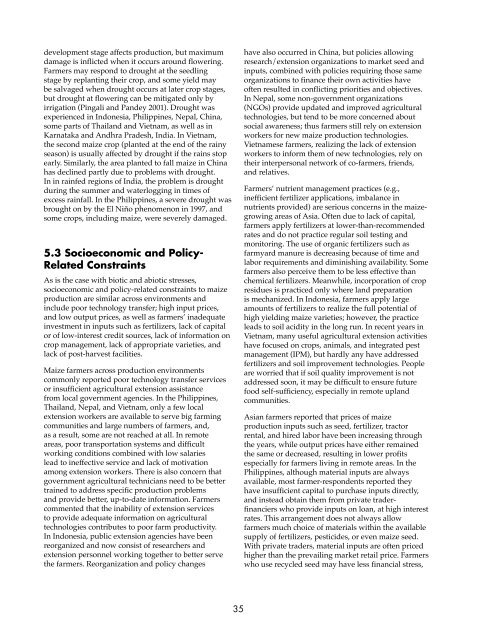CIMMYT - AgEcon Search
CIMMYT - AgEcon Search
CIMMYT - AgEcon Search
- No tags were found...
Create successful ePaper yourself
Turn your PDF publications into a flip-book with our unique Google optimized e-Paper software.
development stage affects production, but maximumdamage is inflicted when it occurs around flowering.Farmers may respond to drought at the seedlingstage by replanting their crop, and some yield maybe salvaged when drought occurs at later crop stages,but drought at flowering can be mitigated only byirrigation (Pingali and Pandey 2001). Drought wasexperienced in Indonesia, Philippines, Nepal, China,some parts of Thailand and Vietnam, as well as inKarnataka and Andhra Pradesh, India. In Vietnam,the second maize crop (planted at the end of the rainyseason) is usually affected by drought if the rains stopearly. Similarly, the area planted to fall maize in Chinahas declined partly due to problems with drought.In in rainfed regions of India, the problem is droughtduring the summer and waterlogging in times ofexcess rainfall. In the Philippines, a severe drought wasbrought on by the El Niño phenomenon in 1997, andsome crops, including maize, were severely damaged.5.3 Socioeconomic and Policy-Related ConstraintsAs is the case with biotic and abiotic stresses,socioeconomic and policy-related constraints to maizeproduction are similar across environments andinclude poor technology transfer; high input prices,and low output prices, as well as farmers’ inadequateinvestment in inputs such as fertilizers, lack of capitalor of low-interest credit sources, lack of information oncrop management, lack of appropriate varieties, andlack of post-harvest facilities.Maize farmers across production environmentscommonly reported poor technology transfer servicesor insufficient agricultural extension assistancefrom local government agencies. In the Philippines,Thailand, Nepal, and Vietnam, only a few localextension workers are available to serve big farmingcommunities and large numbers of farmers, and,as a result, some are not reached at all. In remoteareas, poor transportation systems and difficultworking conditions combined with low salarieslead to ineffective service and lack of motivationamong extension workers. There is also concern thatgovernment agricultural technicians need to be bettertrained to address specific production problemsand provide better, up-to-date information. Farmerscommented that the inability of extension servicesto provide adequate information on agriculturaltechnologies contributes to poor farm productivity.In Indonesia, public extension agencies have beenreorganized and now consist of researchers andextension personnel working together to better servethe farmers. Reorganization and policy changeshave also occurred in China, but policies allowingresearch/extension organizations to market seed andinputs, combined with policies requiring those sameorganizations to finance their own activities haveoften resulted in conflicting priorities and objectives.In Nepal, some non-government organizations(NGOs) provide updated and improved agriculturaltechnologies, but tend to be more concerned aboutsocial awareness; thus farmers still rely on extensionworkers for new maize production technologies.Vietnamese farmers, realizing the lack of extensionworkers to inform them of new technologies, rely ontheir interpersonal network of co-farmers, friends,and relatives.Farmers’ nutrient management practices (e.g.,inefficient fertilizer applications, imbalance innutrients provided) are serious concerns in the maizegrowingareas of Asia. Often due to lack of capital,farmers apply fertilizers at lower-than-recommendedrates and do not practice regular soil testing andmonitoring. The use of organic fertilizers such asfarmyard manure is decreasing because of time andlabor requirements and diminishing availability. Somefarmers also perceive them to be less effective thanchemical fertilizers. Meanwhile, incorporation of cropresidues is practiced only where land preparationis mechanized. In Indonesia, farmers apply largeamounts of fertilizers to realize the full potential ofhigh yielding maize varieties; however, the practiceleads to soil acidity in the long run. In recent years inVietnam, many useful agricultural extension activitieshave focused on crops, animals, and integrated pestmanagement (IPM), but hardly any have addressedfertilizers and soil improvement technologies. Peopleare worried that if soil quality improvement is notaddressed soon, it may be difficult to ensure futurefood self-sufficiency, especially in remote uplandcommunities.Asian farmers reported that prices of maizeproduction inputs such as seed, fertilizer, tractorrental, and hired labor have been increasing throughthe years, while output prices have either remainedthe same or decreased, resulting in lower profitsespecially for farmers living in remote areas. In thePhilippines, although material inputs are alwaysavailable, most farmer-respondents reported theyhave insufficient capital to purchase inputs directly,and instead obtain them from private traderfinancierswho provide inputs on loan, at high interestrates. This arrangement does not always allowfarmers much choice of materials within the availablesupply of fertilizers, pesticides, or even maize seed.With private traders, material inputs are often pricedhigher than the prevailing market retail price. Farmerswho use recycled seed may have less financial stress,35

















